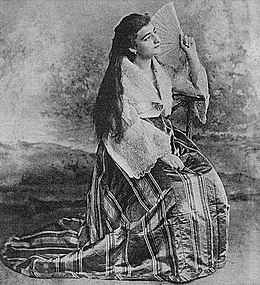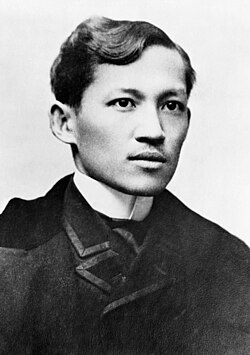 A native Filipina of mixed Spanish ancestry, wearing the traditional Maria Clara gown of the Philippines and the long hair tradition of Filipino women during the colonial era. | |
| Total population | |
|---|---|
| Historical statistics: 5% of the population during the 1700s.[1][2] Present-day statistics: • Philippines: 4,952 indentified as "Spanish" (2020 census)[3] • Spain: 200,000[4] (2018 Census) • Latin America: 5,479[5][6] • United States (Puerto Rico): 91,620[7] | |
| Regions with significant populations | |
| Philippines • Spain • United States • Latin America | |
| Languages | |
| Spanish (Philippine • Castilian) Spanish creole (Chavacano) Filipino (Tagalog • Philippine languages) English (Philippine) | |
| Religion | |
| Christianity • Roman Catholic | |
| Related ethnic groups | |
| Other Filipinos and Spanish people |
 Flag of the Hispanic people | |
| Regions with significant populations | |
|---|---|
| Metro Manila, Zamboanga City, Cebu City, Vigan, Iloilo City, Bauang | |
| Languages | |
| Spanish (Philippine), Filipino-Tagalog, other Philippine languages, English and Chavacano | |
| Religion | |
| Roman Catholic |
| Part of a series on the |
| Spanish people |
|---|
 Rojigualda (historical Spanish flag) |
| Regional groups |
Other groups
|
| Significant Spanish diaspora |
|
|
Spanish Filipino or Hispanic Filipino (Spanish: español filipino / hispano filipino / peninsular filipino/ insular filipino / criollo filipino/ latino filipino/ filipino indígena; Filipino/Tagalog: kastílâ filipino; Cebuano: katsílà filipino; Hiligaynon: katsílà filipino) are an ethnic and a multilingualistic group of Spanish descent and Spanish-speaking individuals native to the Philippines. They consist of Peninsulares, Insulares or white Criollos, Filipino mestizos and people via South America who are descendants of the original Spanish settlers during the Spanish colonial period who form part of the Spanish diaspora and who may or may not speak the Spanish language.
Many of their communities trace their ancestry to the early settlers from Spain and Latin America, and depending on the specific province in the Philippines, in the late 1700s to early 1800s they formed as much as 19% in the capital city of Manila at formerly named Tondo province,[1]: 539 and about 1.38% of the Ilocos region,[2]: 31 2.17% of Cebu[2]: 113 or 16.72% of Bataan[1]: 539 and other parts of the country.
Spaniards, Latin Americans and Spanish-speaking Filipinos are referred to by native Filipinos as "Kastila", a word for "Castilian" which means the region and language of Castile, or an individual of Spanish heritage. Native Filipinos in historical terms are referred to by the Spaniards as "gente morena" (brown people) or "Indio" (a word for "Indian" or native people). Those Filipinos of Peninsular, Criollo and Latino backgrounds number about 4,952 people, while those Filipinos who look or have mixed physical appearances from indigenous and white, are descendants from European or American settlers, or those of mixed ancestry from present-day interracial marriages from White people, are called "Tisoy", a Filipino slang word for "Mestizo" (a Spanish word for "mixed", or a person of mixed indigenous and white ancestry). This mixed ethnic group comprises about 5% of the Philippines' population during the 1700s.[1][2]
The abrupt decline of Spanish Filipinos as a percentage of the population is due to the events of the Philippine Revolution during the Philippine Republic in the late 1800s, as Filipinos of Spanish heritage choose to identify themselves as pure native Filipino, as part of establishing a united national identity in the country,[8] or some have relocated back to Spain, or have migrated to other countries during that period.
During and after the Philippine Revolution, the term "Filipino" included people of all nationalities and race, born in the Philippines.[9][10][11]



Today, Hispanic Filipinos are found in all social class, from upper wealthy to lower poor disadvantage backgrounds, and from high profiled individuals to ordinary unknown people. They have long integrated into the native communities living their lives as ordinary citizens. However most of the successful individuals are present in economics and business sectors in the Philippines and a few sources estimate companies which comprise a significant portion of the Philippine economy like International Container Terminal Services Inc., Manila Water, Integrated Micro-Electronics, Inc., Ayala Land, Ynchausti y Compañia, Ayala Corporation, Aboitiz & Company, Union Bank of the Philippines, ANSCOR, Bank of the Philippine Islands, Globe Telecom, Solaire Resort & Casino, and Central Azucarera de La Carlota, to name but a few are owned by Hispanic Filipinos.[12][13][14][15][16]
- ^ a b c d "ESTADISMO DE LAS ISLAS FILIPINAS TOMO PRIMERO By Joaquín Martínez de Zúñiga (Original Spanish)" (PDF). 1893. Archived (PDF) from the original on March 9, 2016. Retrieved February 3, 2024.
- ^ a b c d ESTADISMO DE LAS ISLAS FILIPINAS TOMO SEGUNDO By Joaquín Martínez de Zúñiga (Original Spanish)
- ^ "Ethnicity in the Philippines (2020 Census of Population and Housing)". psa.gov.ph. Table 5. Archived from the original on July 20, 2023. Retrieved December 25, 2023.
- ^ "Economic diplomacy is as important as OFW diplomacy". BusinessWorld. June 24, 2018.
- ^ "Statistics: Commissions on Overseas Filipinos". Office of the President of the Philippines. November 1, 2024.
- ^ "Asian Diasporas to Latin America and the Caribbean" (PDF). lasaweb.org. November 1, 2024.
- ^ "Distribution of Filipinos Overseas (Statistics On Filipinos Overseas". The Republic Of the Philippines (Department of Foreign Affairs. December 1, 2014.
- ^ Doeppers, Daniel F. (1994). "Tracing the Decline of the Mestizo Categories in Philippine Life in the Late 19th Century". Philippine Quarterly of Culture and Society. 22 (2): 82. JSTOR 29792149.
- ^ Hedman, Eva-Lotta; Sidel, John (2005). Philippine Politics and Society in the Twentieth Century: Colonial Legacies, Post-Colonial Trajectories. Routledge. p. 71. ISBN 978-1-134-75421-2. Retrieved July 30, 2020.
- ^ Steinberg, David Joel (2018). "Chapter – 3 A SINGULAR AND A PLURAL FOLK". THE PHILIPPINES A Singular and a Plural Place. Routledge. p. 47. doi:10.4324/9780429494383. ISBN 978-0-8133-3755-5.
The cultural identity of the mestizos was challenged as they became increasingly aware that they were true members of neither the Indio nor the Chinese community. Increasingly powerful but adrift, they linked with the Spanish mestizos, who were also being challenged because after the Latin American revolutions broke the Spanish Empire, many of the settlers from the New World, Caucasian Creoles born in Mexico or Peru, became suspect in the eyes of the Iberian Spanish. The Spanish Empire had lost its universality.
- ^ Doeppers, Daniel F. (1994). "Tracing the Decline of the Mestizo Categories in Philippine Life in the Late 19th Century". Philippine Quarterly of Culture and Society. 22 (2): 80–89. ISSN 0115-0243. JSTOR 29792149.
- ^ "The Basques's contribution to the Philippines". Archived from the original on January 22, 2018. Retrieved May 12, 2016.
- ^ "Ayala Group". Archived from the original on July 28, 2011. Retrieved May 12, 2016.
- ^ "Aboitiz and Company - About Us". Archived from the original on August 12, 2022. Retrieved May 12, 2016.
- ^ "ICTSI - BOD - Enrique K. Razon Jr". Archived from the original on September 26, 2018. Retrieved May 12, 2016.
- ^ "ANSCOR - History". Archived from the original on August 17, 2022. Retrieved May 12, 2016.